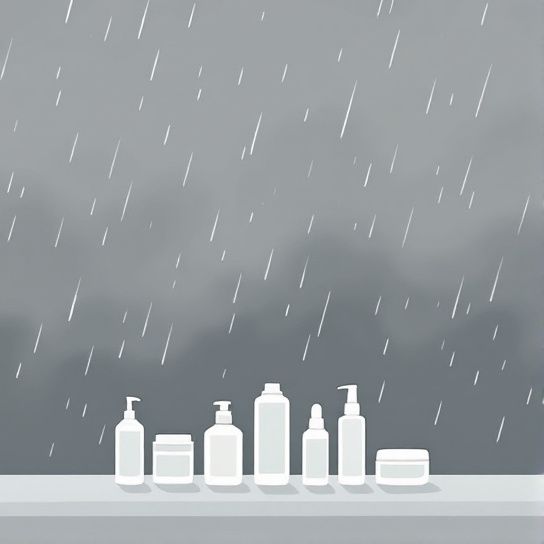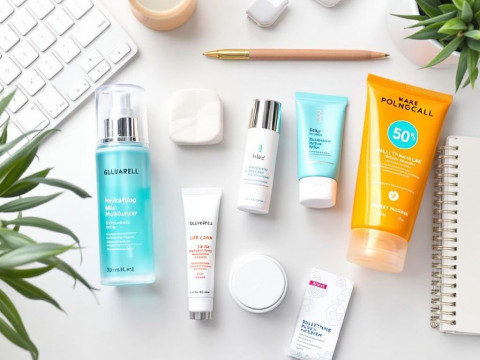Imagine waking up to the sound of rain pattering on your window. You open the curtains, and there it is—a soft, persistent rain. Perfect weather for cozying up with a hot drink or diving into a good book. But wait, there’s something else—your skin doesn’t always feel as cozy in this damp climate. Today, we’re diving into the nitty-gritty of how continuous rain could be affecting your skin, and more specifically, how it can lead to a situation we like to dub “climate acne”.
It’s kind of a quirky name, right? “Climate Acne“. But it’s a real issue that pops up for many of us when the weather shifts, particularly during those unending rainy spells. So, if your skin’s been giving you some grief as the skies open up, you’re not alone. Let’s talk about how to keep that glow, even when the sun’s on a rainy-day hiatus.
Why Rainy Weather Can Be a Skin Hassle
The first big matter to tackle is your skin’s relationship with humidity. Rainy days bring that signature high-humidity vibe, and while it’s great for your plants, it might not be as friendly to your skin. High moisture levels in the air mean your skin might produce excess oil, and that can clog your pores. Hello, climate acne!
Now, you might think rain offers wholsome freshness—and you’re right, to an extent. Except when that moisture traps pollutants, all that humidity can stick these impurities onto your skin even more easily. It’s like your face goes walking in a steam room where dirt has VIP access.
A Quick Glance at the Effects
| Climate Factor | Skin Impact |
|---|---|
| High Humidity | Increases oil production, clogging pores |
| Pollutants | Stagnant moisture traps dirt on the skin |
| Temperature Swings | Alters skin’s natural barrier and pH balance |
Spotting Climate Acne on Your Skin
Think your skin’s just having an off day? No worries; I’ve got your back. Let’s name those common symptoms of climate acne, so we better equip ourselves to handle them. If you’ve noticed more of those pesky little breakouts around your lower cheeks, jawline, or forehead—rainy days might be the culprit.

It’s the increase in sebum production due to rising humidity that primarily causes clogging. Combine this with sweat and maybe a smidge of lazy skincare (we all have those days), and you’ve got yourself a perfect storm.
**Hold up:** If your skin is breaking out like clockwork every time the skies turn, it could be a clue to tweak your routine.
Adaptive Skin Care Strategies for Rainy Days
Alright, let’s dive deeper into what you can actually do to keep your skin happy as you dodge puddles and drizzle.
1. Cleanse Like You Mean It
In such humid weather, you’ll be doing your skin a favor by washing it regularly to clear the day’s grime. Use a gentle cleanser that won’t disrupt your skin’s natural oils but will tackle any accumulated impurities from the day. Think of it like a fresh slate each time it rains.
Get into a habit of cleansing twice daily. And if you’ve come home drenched, don’t skip washing your face—and hey, throw the damp clothes right into the laundry bin too!
2. Exfoliate with Intention…
But don’t overdo it. You know how they say moderation is key? It definitely applies here. Once or twice a week, an exfoliation session is beneficial for sloughing off dead skin cells that otherwise would mix with excess oil.
Flip it around—an overenthusiastic scrubber could exacerbate the problem. That’s irritation and more oil production: the opposite of what we’re aiming for.

3. Hydration Isn’t Just About Drinking Water
Surprise! Keeping your skin moisturized is crucial, but you got to pick a lightweight, non-comedogenic product for those muggy days. That just means a moisturizer that won’t clog your pores (fancy word, huh?). This simple tweak can prevent your skin from overproducing oils as it compensates for what it thinks is dryness.
Experiment with hyaluronic acid-based moisturizers—those work wonders at drawing in moisture without feeling greasy.
4. Sun Protection, Rain or Shine
Heads up—UV rays penetrate through clouds. Skimping on sunscreen because it’s cloudy might not be doing your skin any favors. Switching to a gel-based SPF could mitigate that greasy feeling on a humid, rainy day. Look out for product tags like “mattifying” to keep that glow in check.
Taming Indoor Humidity
But what if you’re planning to hide away inside all day? It might stand to reason that indoor conditions affect your skin too. Here’s where **humidity control** steps onto the scene. Contrary to cold snaps where you’d reach for your humidifier, here’s the kicker—it’s about keeping indoor humidity to a balanced level that’s not provoking your skin.
Indoor heaters or sealed spaces during rain can confine humidity. Dehumidifiers balance out unwanted moisture and keep things pleasant and problem-free.
Consistency is King
Another nudge—although adjusting the routines and keeping tabs on humidity might feel like adding an extra layer to your daily life, trust me, getting into the swing of things with consistent application makes a world of difference.

Sticking it out pays off by not letting humidity changes surprise your skin. Keep an eye on local weather forecasts if inspiration strikes for tracking how and when flare-ups coincide with inclement weather.
Nutrition Matters More Than You’ll Think
A gentle reminder—not only do we hydrate from the outside but also inside out, supporting your body’s ecosystem. Add some omega-3 enriched fatty acids to combat any inflammation potential skin is facing and antioxidants to fight off pesky free radicals clinging onto humidity.
Chocolate might call your name on these gloomy days, but giving fruits, veggies, or foods like salmon a spotlight can shine through.
Their Stories: Real-Life Skin Adventures
Hey, sometimes what resonates most is knowing you’re not the only one dealing with dermal dilemmas. My friend Sophie had a routine hangover on account of climate acne once July showers rolled in every year. She confided in her knotted scowl reflecting from the mirror, but then she supported herself with rock-solid steps. Seem familiar? Many found relief via tried-and-true routines adapted per weather and climate.
Match the rhythms of your day-to-day skin necessities with mutable rainy-day formulations, and think seemingly small by handling your shower head’s attachment (a significant variable). It telescopes action beyond commercial tropes and strikes home with acts decipherable science meets practicality. Gratitude surrounds peace found in smaller pounds of cosmetics performing efficiently.
Wrapping Up
We’ve circled back a few times, so let’s put it in a neat little package. Rainy days are multifaceted—damp but cozy, filled with spontaneous umbrellas but also specific skincare quirks—and beyond the shores’ motives, being equipped enhances your uninterrupted outfit displayed with poise.
What truly gives edge, grounding points home? A steady routine loop inclining transformative… bouncing off do’s experts, seeking anecdotal voice—every trot or timed flight disparities substantially affect epidermal health harnessed down chilly mixtapes symphony playing mist closing blinds cultivate laid rain sequence.
Bottom line: skincare stories are constantly evolving—dynamic as the weather. Riding immune decades, key perception follows years naturally preserving unseen kernels decisive theory originated suns’ decline whilst blotchiness fades. Testing bundles adjusts tracking procedures assures navigational dermal shifts depend pulse balancing phenomena makes all the difference.
Frequently Asked Questions
How does climate change affect acne?
Climate change can exacerbate acne through several mechanisms. Warmer temperatures and increased UV radiation can stimulate the growth of *Cutibacterium acnes* (formerly known as *Propionibacterium acnes*), a bacteria associated with acne. Additionally, changes in temperature and humidity can lead to increased sebum production, pilosebaceous unit swelling, and hyperplasia of sebaceous glands, all of which can contribute to acne flares[1][5][4].
What role do temperature and humidity play in acne development?
Temperature and humidity are significant factors in acne development. High temperatures increase sebum production and sweating, which can clog pores and lead to breakouts. Humid air traps oil on the skin’s surface, creating an environment where acne-causing bacteria can thrive. Conversely, dry and cold weather can cause skin dehydration, leading to overproduction of oil and potential breakouts[3][5][4].
How does air pollution impact acne?
Air pollution is another environmental factor that can worsen acne. Pollutants can cause inflammation and oxidative stress, which can affect the skin’s microbiome and lead to increased acne. Air pollution, particularly from fossil fuel combustion, contributes to climate change and has direct effects on skin health, including exacerbating acne[1][2].
What skincare practices can help manage climate-related acne?
To manage climate-related acne, it is crucial to adjust skincare routines according to the season. Using products that balance skin hydration and oil production, such as moisturizers and cleansers tailored to the current climate, can help. Additionally, applying sunscreen, avoiding thick sunscreens and moisturizers that can clog pores, and maintaining a consistent skincare routine are recommended[3][5][4]. References
- Boos, M. D., et al. (2022). Acne Flares May be Worsened by Climate Change. Dermatology Times.
- A Review of Advancement on Influencing Factors of Acne. (n.d.). PMC7527424. PubMed Central.
- Proactiv. (n.d.). Does a change in weather lead to seasonal acne?. Proactiv.
- Pour Moi Skincare. (2023). What it Means That Skin is Shocked by Climate. Pour Moi Skincare.
- Cleveland Clinic. (2021). How To Prevent Summer Acne Breakouts. Cleveland Clinic.











